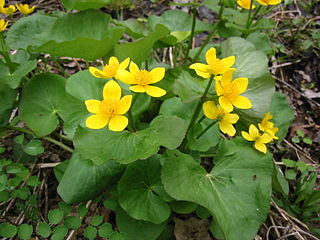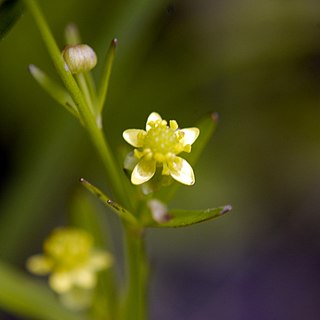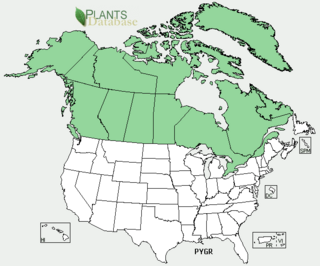
Ranunculus repens, the creeping buttercup, is a flowering plant in the buttercup family Ranunculaceae, native to Europe, Asia and northwestern Africa. It is also called creeping crowfoot and sitfast.

Caltha is a genus of rhizomatous perennial flowering plants in the family Ranunculaceae, to which ten species have been assigned. They occur in moist environments in temperate and cold regions of both the Northern and Southern Hemispheres. Their leaves are generally heart-shaped or kidney-shaped, or are characteristically diplophyllous. Flowers are star shaped and mostly yellow to white. True petals and nectaries are missing but the five or more sepals are distinctly colored. As usual in the buttercup family there is a circle of stamens around free carpels.

Ranunculus lapponicus, the Lapland buttercup, is distributed all over the arctic, with the exception of northern and eastern Greenland.

Ranunculus glacialis, the glacier buttercup or glacier crowfoot, is a plant of the family Ranunculaceae. It is a 5-10(-20) cm high perennial herb. Often with a single relatively large flower, with 5 petals first white later pink or reddish. The underside of the 5 sepals are densely brown-hairy. The leaves are fleshy, shiny, and deeply loped, forming 3 leaflets. Chromosome number of Ranunculus glacialis is 2n = 16, reported from Greenland material.

Ranunculus bulbosus, commonly known as bulbous buttercup or St. Anthony's turnip, is a perennial flowering plant in the buttercup family Ranunculaceae. It has bright yellow flowers, and deeply divided, three-lobed long-petioled basal leaves.

Ranunculus acris is a species of flowering plant in the family Ranunculaceae, and is one of the more common buttercups across Europe and temperate Eurasia. Common names include meadow buttercup, tall buttercup, common buttercup and giant buttercup.

Geranium bicknellii is a species of geranium known by the common names Bicknell's cranesbill and northern cranesbill. It is native to much of the northern half of North America, where it can be found in a number of forest and woodland habitats. This is an annual or biennial herb which grows hairy stems up to about half a meter long. It may be erect or lie near the ground. Each leaf is several centimeters long and wide and is divided into several lobes, each of which may have smaller lobes or teeth. Flowers grow singly or in pairs and have pointed sepals and small lavender petals, each with a notch in the tip. The fruit has a rounded body with a long, straight style about 2 centimeters in length and tipped with a small beak.

Ranunculus eschscholtzii is a species of buttercup flower known by the common name Eschscholtz's buttercup.

Ranunculus recurvatus, the blisterwort or hooked crowfoot, is a plant species of the genus Ranunculus in the family Ranunculaceae native to eastern North America. It is an early-flowering plant of moist deciduous woods from central Quebec south to Florida.

Ranunculus auricomus, known as goldilocks buttercup or Greenland buttercup, is a perennial species of buttercup native to Eurasia. It is a calcicole typically found in moist woods and at the margins of woods. It is apomictic, and several hundred agamospecies have been recognised.

Anemonastrum richardsonii, commonly known as yellow thimbleweed, is named after a Scottish naturalist, Sir John Richardson (1787–1865) who found it on Franklin's expedition to the Arctic. It is a perennial, deciduous plant that blooms in mid to early June.

Ranunculus pedatifidus is a species of buttercup known by the common names surefoot buttercup, northern buttercup, and birdfoot buttercup. It has a circumpolar distribution, occurring throughout the northern latitudes of the Northern Hemisphere. There are two varieties, var. pedatifidus occurring mostly in Asia and var. affinis mostly native to North America.
Ranunculus allenii, commonly known as Allen's buttercup, is a flowering plant in the crowfoot or buttercup family, Ranunculaceae. Generally found in wetlands in northern latitudes, it bears yellow flowers in summer, which are pollinated by insects.

Ranunculus abortivus is a species of flowering plant in the buttercup family, Ranunculaceae. Its common names include littleleaf buttercup, small-flower crowfoot, small-flowered buttercup, and kidneyleaf buttercup. It is widespread across much of North America, found in all ten Canadian provinces as well as Yukon and the Northwest Territories, and most of the United States, except Hawaii, Oregon, California, and parts of the Southwest.

Pyrola grandiflora (pronunciation , commonly known as Arctic wintergreen or largeflowered wintergreen, is a hardy perennial evergreen subshrub in the family Ericaceae. It is widely distributed in the Northern Hemisphere from temperate to tundra-like climates.
Luzula nivalis, commonly known as arctic wood-rush or less commonly as snowy wood-rush, is a species of perennial rush native to the North American Arctic and Northern Europe. It was described by Polunin (1940) as one of the most abundant, ubiquitous, and ecologically important of all arctic plants.
Luzula wahlenbergii, commonly known as Wahlenberg's woodrush or reindeer wood-rush, is a perennial species of plant in the genus Luzula of the (rush) family Juncaceae.

Ranunculus acaulis, in Australia and New Zealand called dune buttercup, sand buttercup or shore buttercup, is a yellow-flowered, small, fleshy herb, that grows in mats in damp places mostly near the sea. It occurs naturally in Australia, New Zealand, Chile and the Falklands. It flowers between August and April and sets seed from September till July.

Ranunculus pinguis is a dark green, fleshy-leaved buttercup with relatively large, short-stalked flowers and narrow stiff yellow petals that grows in tufts. It is an endemic species of New Zealand on the Auckland and Campbell Islands that flowers from December to January and sets seeds between February and April.

Ranunculus allegheniensis is a species of flowering plant in the buttercup family, Ranunculaceae. Its common names include Allegheny Mountain buttercup and Allegheny crowfoot.
















